The Badge and Other Forms of Identification in the U.S. Marshals Service
U.S. Marshals and their deputies have excelled for over 200 years, but a common object over time is the identifying instrument and documentation presented while conducting agency business. A badge denoted official operational capacity and the special merit that characterized our personnel.
Whether the badge was a six-sided "tin star" made famous in western movies or a circular shape specifying the individual branch of duty, the badge has become a legend on its own.
There was no uniform badge in the U.S. Marshals Service (USMS) until 1941, when the "Eagle Top" variety was introduced nation-wide. Prior to this time, the badges came in different shapes and forms. Each district made its own identifying badge. Other forms of official notice came in the form of election official ribbons, photo identification credentials, patches, and business cards.
There have been a wide range of designs of badges that were worn by U.S. Marshals and their deputies in the past two hundred years (Stylized badge worn about the turn of the century) See More Badges
Special instructions were sometimes provided for the display of identification. (enlarged photo on left)
One example denoted a federal election in California in the early 1880's. U.S. Marshal Moses M. Drew posted an eight point instruction sheet, including the proper etiquette in wearing the badge.
The first numbered point stated, "Each deputy will wear his badge of office outside, on the left lapel of his coat during the time he shall be on duty."
Since 1980, the badge has been worn with credentials in one unit. The old shield-shaped badge changed twice, the present form being a star within a circular ring. Whatever the shape and symbolism, the U.S. Marshals badge will always be identified with its legendary mission.
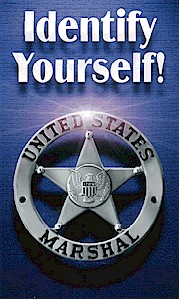 |
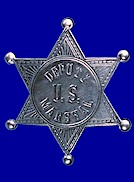 |
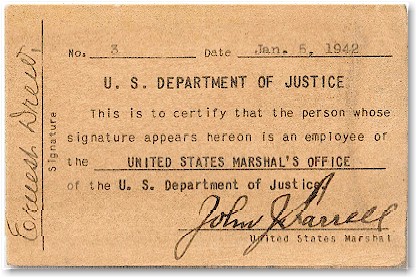
|
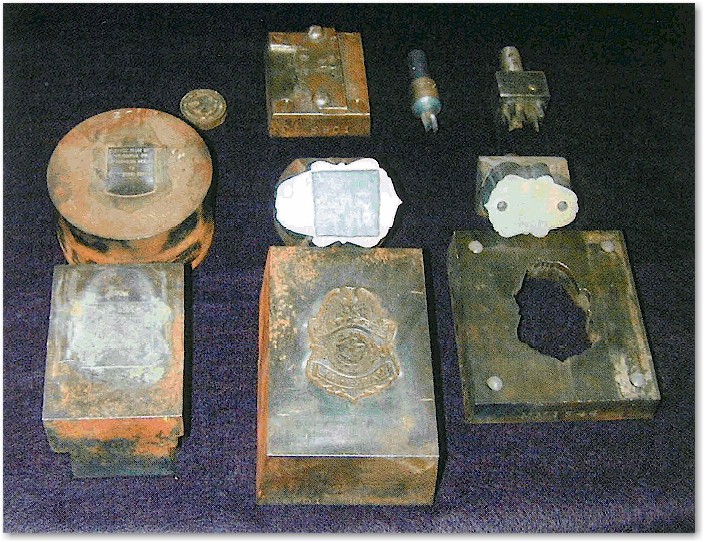
|
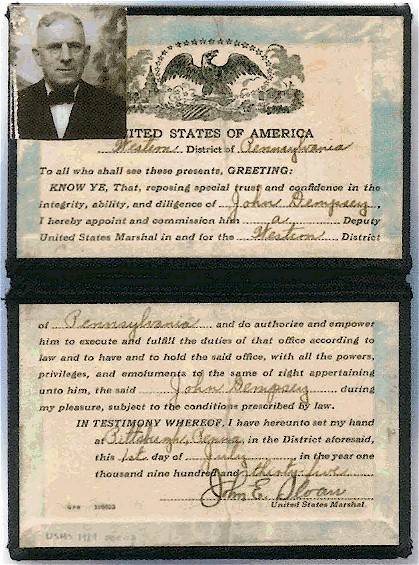
|
Credentials - A Badge unto Itself
The credential was official notice of agency powers and since September 1980 the second part of the official badge unit. In earlier times, it showed the actual deputation rank such as Field Deputy or Office Deputy. The U.S. Marshal for each district was required to sign the credential. Later this requirement changed to the director. As important and reassuring as the badge, it was the true authorization to perform assigned duties. (enlarged version of credentials shown on right)
The Seal
The official seal of the United States Marshals Service was established in December 1968 by Order Number 407-68. Authority was vested in Attorney General Ramsey Clark by Section 509 of title 28 and Section 301 of Title 5 of the United States Code to produce the official symbolic design. The road to the final decision took six years. In June 1964 the agency began groundwork inquiries for the official establishment of a representative seal. U.S. Marshals and their employees were encouraged to send in their ideas.
In October 1966, U.S. Marshal Robert F. Morey of the District of Massachusetts was part of a committee tasked by Chief United States Marshal James J.P. McShane to review various drawings and submissions. The prototype design was ready by Autumn 1968.
The seal was a fascinating mixture of symbolism and patriotic color. It contained the six-pointed star of a western resemblance, surrounded by a field of deep blue. The field contained this color to represent the same symbols as in the American flag: vigilance, perseverance, and justice. Over the badge was an American bald eagle that clutched two symbols in its talons: an olive branch in one and arrows in the other. A small breastplate was superimposed over the symbolic eagle and showed all three flag colors and the date "1789," the first year of the agency's existence. A red ring was outside of the solid blue background, signifying courage and bloodshed in carrying out duties. Thirteen stars are over the top half of the seal, while the agency motto: "Justice, Integrity, Service" is denoted on the bottom half. Finally a gold-colored ring on the outside stated the words "Department of Justice" and "United States Marshal." The outer edge was brown-colored to signify the Earth.
Chief U.S. Marshal McShane wanted to bring the districts together with a common bond that promoted its common mission. He noted in a memo to Attorney General Clark that the seal would "further our development of unity and cooperation." The Attorney General's Office sent the proposal through the Army Heraldry Service, the Government Printing Office, and the Office of Legal Counsel to assure the image followed guidelines. The Official notice was given six days later.
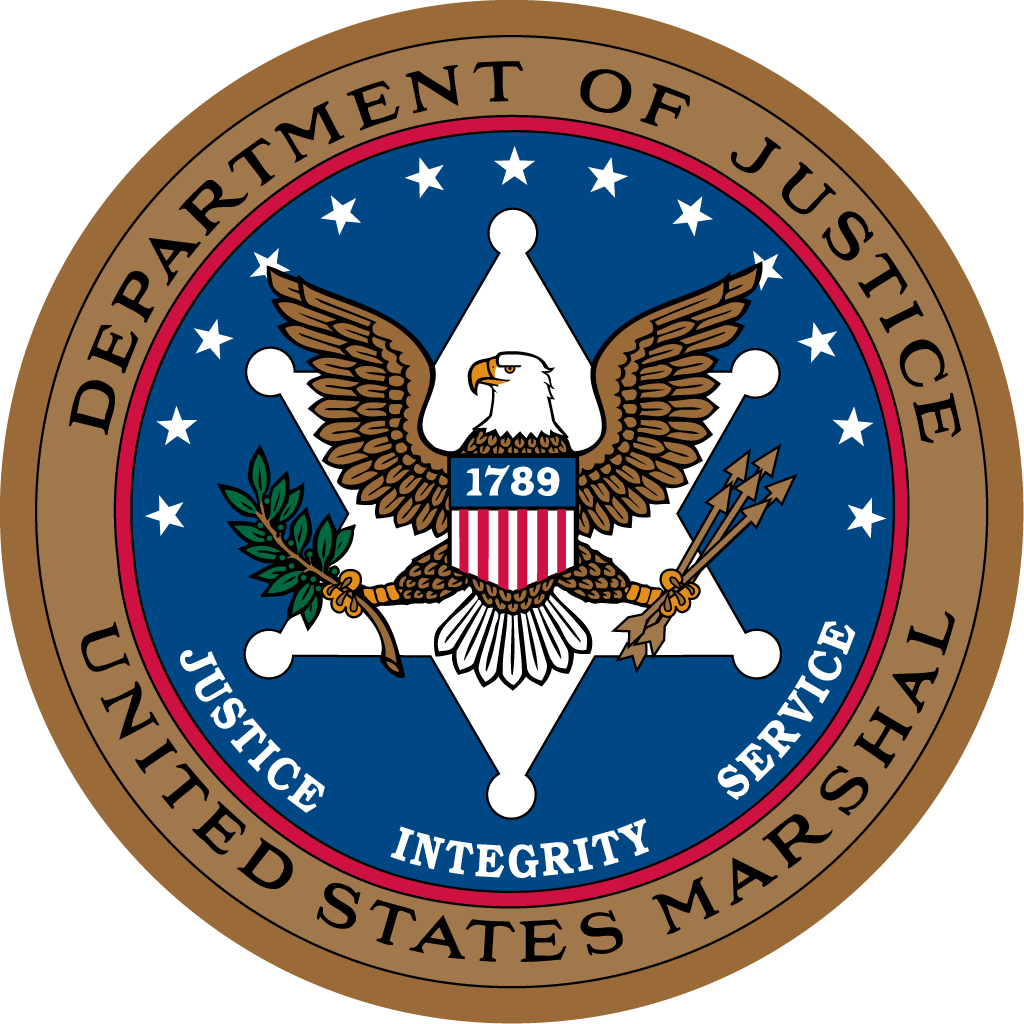 |
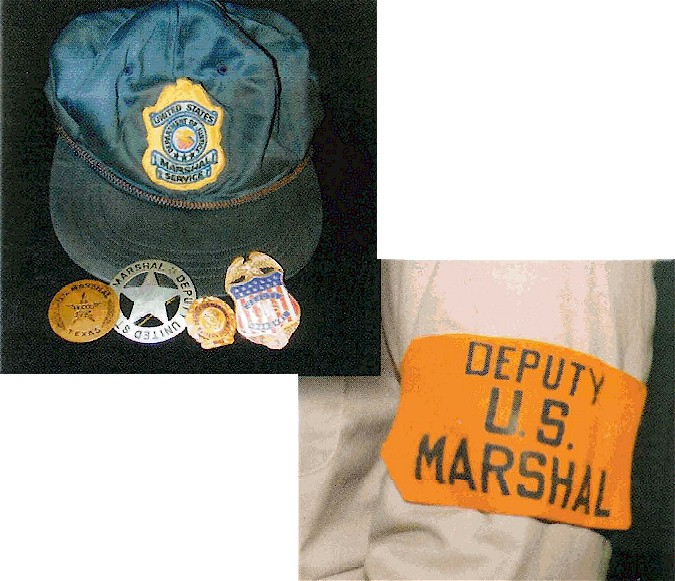
|
Armbands and Caps
During special events, particularly in the Civil Rights Era, saw the prominent use of agency armbands for identification. In several high-profile events, such as the integration of the University of Mississippi (1962) and the Pentagon Riots (1967), the armband is symbolic. Norman Rockwell's painting, "'The Problem We All Live With," features four deputies escorting a young African-American girl to school surrounded by signs of racial tension. It was inspired by four actual deputies escorting first-grade student Ruby Bridges to school in New Orleans in 1960. Rockwell did not paint the faces of the deputies, but identified them through their armbands! (enlarged photo)
By the 1970's the cap often provided informal identification as part of official uniform. The Special Operations Group was one of the first to incorporate the prominent identifying cap in operational use.
Business Cards, Buttons, and Miscellany
A more informal notice of identification is the agency business card. Easily accessible, but not an official authorization, the cards relate contact information for the course of business. A large number of these can be collected over the course of a career. Modern varieties show the rank, phone, and official address.
Ribbons for Special Elections
The special deputation for overseeing federal elections brought its own "badge." The ribbon for these events gave the wearer special status for the event. Some were not professional law enforcement personnel, but private citizens deputized for the purpose. There were strict guidelines for the appointees. Section 5521 of the Revised Statutes of the United States stated,
If any person be appointed a Supervisor of Election or a Special Deputy Marshal under the provisions of Title "The Elective Franchise," and has taken the oath of office as such Supervisor of election, or such special Deputy Marshal and thereafter neglects or refuses, without good and lawful excuse, to perform and discharge fully the duties, obligations and requirements of such office, until the expiration of the term for which he was appointed, he shall not only be subject to removal from office, with loss of all pay and emoluments, but shall be punished by imprisonment for not less than six months nor more than one year or by a fine of not less than two hundred dollars and not more than five hundred dollars or by both fine and imprisonment, and shall pay the costs of prosecution.
Due to the large crowds and the need to keep order, special powers were necessary. The silk or cloth ribbons came in different varieties, like the two below for the Elections of 1880 and 1892 from New York City. The victors in these two elections were Republican James Garfield and Democrat Grover Cleveland.
This is a web version of a U.S. Marshals Service Publication, No. 116A: Identify Yourself!
For additional information on the use of the U.S. Marshal Service (USMS) name, badge, seal and other official name/insignia on commercial products, including intellectual properties such as books, movies and software, please contact the USMS Office of Public Affairs at (703) 740-1699.

